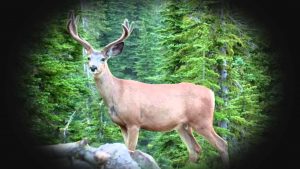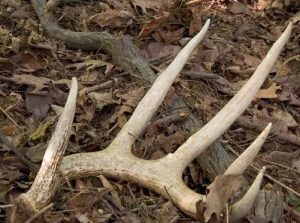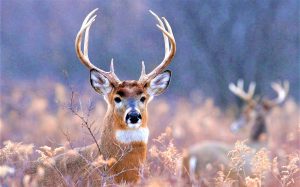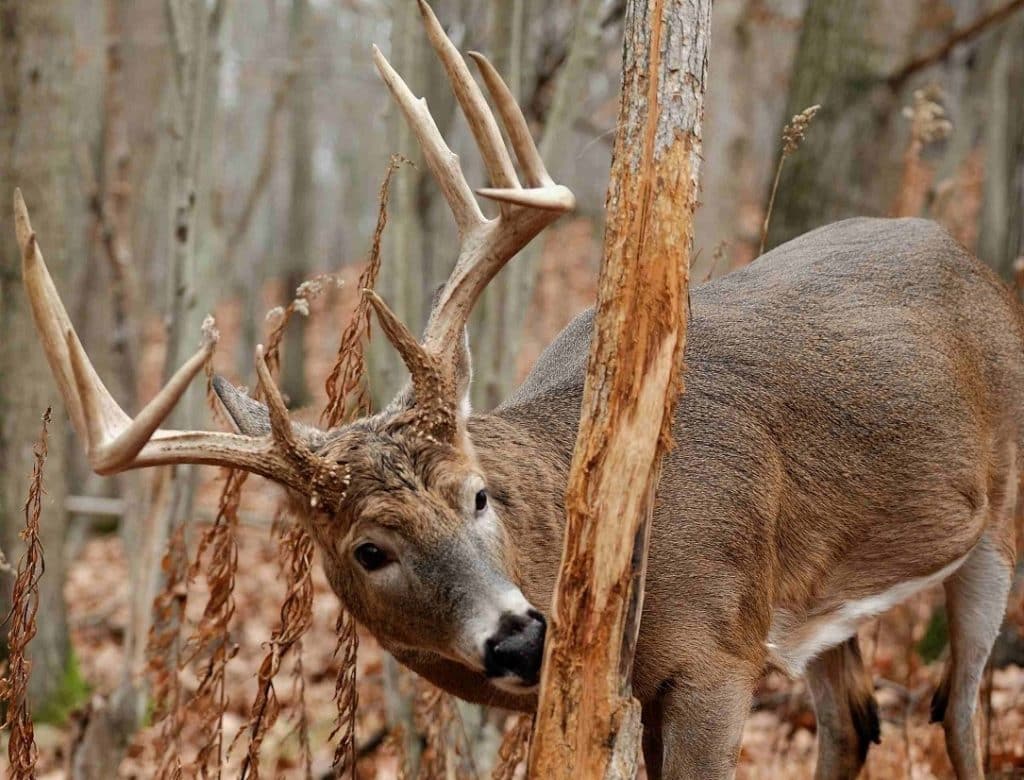If all you’re doing is taking a walk in the woods the weekend before opening day you’re really missing out. Everyone agrees that scouting your hunting territory pays off big during the hunting season. But they don’t tell you how often and when you should actually scout your hunting land. The age-old saying that you should “scout in the preseason”just isn’t working anymore.
Post Season Deer Scouting Tips
When’s The Best Time To Scout For Deer?
Many hunters begin searching the woods a few weeks before deer hunting season. While this tactic is better than nothing it makes things a little bit difficult. During the late summer and early fall you’re going to have to fight through thick dense foliage. If the summer’s been good to you you’ll probably even have to fight through moderate heatstroke and swarms of mosquitos and spider webs.
You might pick up a few tidbits of information during the late summer, but you’re much more likely to pick up a good case of poison ivy. Walking through the woods this time year might work well for bow hunters, but things are going to be a lot different later in the season when rifle season rolls around. Come November all the leaves will be off the trees and deer movements will be completely different. That’s why scouting during the postseason when a little snow might be on the ground is so important.
Postseason Deer Scouting
Immediately after the deer season ends most hunters are going to want to take a break, but that’s the wrong attitude to have. This is one of the best times to do your early scouting when all the foiliage is down and deer are in their late season homes.When all the green is off the trees in the woods are thin you can not only walk easily from place to place deer trails are easy to spot. Deer trails look like freeways running through the forest and all of last seasons scrapes and rubs will be readily apparent.
What do You Need to Scout For Deer?
 Scouting for deer really doesn’t require all that much gear. Normally I’ll just bring along a good pair of hiking boots, a camera/cell phone and a good pair of binoculars. I personally bring along my Steiner 8x22mm Predator binoculars, which are by far the best compact binoculars that I own. Steiner binoculars are all extremely durable and come with a crystal clear sight picture. Any clear pair of binoculars should work well to size up a buck or pick up rubs, scrapes and sheds.
Scouting for deer really doesn’t require all that much gear. Normally I’ll just bring along a good pair of hiking boots, a camera/cell phone and a good pair of binoculars. I personally bring along my Steiner 8x22mm Predator binoculars, which are by far the best compact binoculars that I own. Steiner binoculars are all extremely durable and come with a crystal clear sight picture. Any clear pair of binoculars should work well to size up a buck or pick up rubs, scrapes and sheds.
You Won’t Deal With Poison Ivy and Thorns
By far the worst thing about scouting during the summer and early fall is the poison ivy. Thankfully after the hunting season all the poison ivy has died off you won’t have to deal with those itchy bumps. You’ll be able to easily penetrate those dense thickets that were hidden during the fall. Mapping out these bedding areas is crucial to finding that big buck next year. Might even get a chance to look at escape trails that they use when drawn out of their homes.
Looks Like it Will Next Hunting Season
By far the best thing about postseason hunting is that the forest looks just like it will next hunting season. You’ll be able to scout out all the best hunting areas and find out exactly where you’re going to want to place your stand next year. You’ll be able to take advantage of cover and terrain and if it’s a secure area you might even get to “weather in a stand” so that it looks natural next season.
The most important thing you’ll be able to see is exactly where deer end up at the end of the hunting season. You’ll be able identify all the terrain, travel corridors and feeding patterns of mature seasoned deer.
Scouting During The Winter
Scouting during the winter should be treated just like postseason scouting. Heck depending on the weather and where you live, there’ll probably be a lot of snow on the ground during the hunting season. Scouting during the winter will largely depend on how severe the weather is. In areas where there are mild climates deer spend the winter recovering from the hunting season and go back into their normal preseason habits. In areas where there’s a lot of snow winter Scouting’s probably not to give much benefit. In these areas deer will have came up with strategies that aren’t going to be anywhere near what they would do during the fall.
Find Some Shed Antlers
 Regardless of how much you actually get out of the winter scouting trip there is one primary advantage. That’s the chance to find some shed antlers during your long walks through the woods. Sizable sheds will tell you how big a bucks going to be next year and where he lives. The most important thing that it tells is that he survived the hunting season. Knowing that a big bucks around really makes you focus on the year ahead.
Regardless of how much you actually get out of the winter scouting trip there is one primary advantage. That’s the chance to find some shed antlers during your long walks through the woods. Sizable sheds will tell you how big a bucks going to be next year and where he lives. The most important thing that it tells is that he survived the hunting season. Knowing that a big bucks around really makes you focus on the year ahead.
How Do You Know Bucks Will Be Back Next Year?
You could find a ton of rubs, scrapes and sheds but how do you know he’ll be alive next year. Well you don’t, but where there’s a ton of deer activity one year it will be very likely to repeat itself. Prime breeding areas, food plots and sanctuaries are always going to attract a local deer population. If a hunter takes a large buck in a prime breeding area that spot won’t be open for long. Young mature bucks will come in and take up the mantle.
Experienced bucks are always picky about where they rub. So seeing rubs in the same general location year after year is a great indication that the same buck made them. If you see rubs that are in the same general location but a little bit away it’s very likely the buck was killed and another buck inherited the location.
Scouting For Deer During The Spring
Scouting for deer during the spring is an added bonus, but that’s not why I am out there. Spring is prime turkey hunting season and I’m out there to bag a bird. Spring turkey season is typically pretty long so I usually get a good amount of Scouting in. During the spring I like to keep an eye out for places that I can make a food plot in the next couple weeks. If the weather breaks I might even throwdown some seed to make a quarter acre of heaven.
For more info check out my post on planting food plots or just pick up a bag of Antler King No Plow Mix and toss it on the ground. You’d be surprised just how fast a small 1/4 acre plot of Oats, Rye, Brassica and Clover will bring in a mature buck. It looks natural and you won’t have to worry about laws stopping you from baiting deer. With about fifteen minutes of work you’ll be guaranteed a few mature bucks are hanging around next hunting season.
Scouting During The Summer
Scouting during the summer is going to be just like it is during the early fall. You’ll have a lot of green to deal with and most of the winter patterns will have dropped off. With such an abundance of food deer tend to wander aimlessly and don’t follow their normal patterns. You can’t blame them for taking advantage of the bounty that’s given to them. Summer might not be great for finding bedding areas, but it is great for spotting individual bucks.
Setup a Trail Cam
Summer is the perfect time of year to use the knowledge you learned during the winter and spring to throw down a few trail cameras. Wireless trail cameras like this Wireless Bushnell Trophy Cam work really well but they can be a bit pricey. It really is amazing just how advanced these trail cameras are with GPS capability and 3G wireless capability throughout most of the United States. With crystal clear pictures and night vision modes you really can’t go wrong with a wireless camera.
Personally I like to place one wireless camera in my favorite hunting spot and toss a few of my cheaper trail cams up in other places that look promising. I’ve somehow accumulated 5 of these cheap APEMAN trail cameras throughout the years and they work really well for the price. With a really wide angle lens and clear picture you can’t beat it.
Try to Find One Big Buck

Every summer I like to find one big buck that I like to stalk all year round. I might find 4 or 5 that I’d definitely take home, but I’m always waiting for that one monster buck. Honestly most years if I’m patient enough and did my preseason scouting I’ll end up getting him.
Look For Non-Aggressive Pasturing Deer
Summer is the best time to see what your local herd has to offer. When bucks are growing their velvet antlers they’re often at their least aggressive. They like to hang out in groups of bachelors just munching away in open fields. They’ll even come out to eat during the daylight hours in open fields.
Now’s the time to bring your binoculars out and glass over open fields looking for mature bucks. Whenever you spot a nice buck out in the open take note of it. His travel patterns might change going into the fall, but you’ll know his general range. With a good knowledge of the area gathered in the winter and spring you should have a good idea of where he’s going to be. Spotting a big velvet rack is the best sign for next hunting season.

